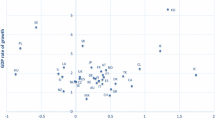Abstract
That there is a trade-off between equityand efficiency (economic growth) is wellknown. Two models have been developed thatlink government spending and taxation toeconomic growth. This paper uses thesemodels to provide estimates of thegrowth-maximizing tax rate. Then, a twoequation structural model is developed andestimated that is used to find thetrade-off rate between economic growth andincome inequality and the growth-maximizinglevel of income inequality for the UnitedStates over the period 1960–1990.
Similar content being viewed by others
References
Barro, R. (1990). Government spending in a simple model of endogenous growth. Journal of Political Economy 98: S103-S125.
Buchanan, J.M. (1965). An economic theory of clubs. Economica 32: 1-14.
Coase, R.H. (1974). The lighthouse in economics. Journal of Law and Economics 17: 357-376.
Deininger, K. and Squire, L. (1996). A new data set measuring income inequality. World Bank Economic Review 10: 565-591.
Dickey, D.A. and Fuller, W.A. (1981). Likelihood ratio statistics for autoregressive time series with a unit root. Econometrica 49: 1057-1072.
Economic Report of the President 1996. (1996). Washington.
Forbes, K.J. (2000). A reassessment of the relationship between inequality and growth.American Economic Review 90: 869-887.
Gwartney, J., Lawson, R. and Holcombe, R. (1998). The size and functions of government and economic growth. Washington: Joint Economic Committee.
Hansson, P. and Henrekson, M. (1994) A new framework for testing the effect of government spending on growth and productivity. Public Choice 81: 381-401.
Hsiao, C. (1981). Autoregressive modelling and money-income causality direction.Journal of Monetary Economics 7: 85-106.
Kocherlakota, N. and Yi, K.M. (1996). A simple time series test of endogenous vs. exogenous growth models: An application to the United States. Review of Economics and Statistics. 78: 126-134.
Koester, R.B. and Kormendi, R.C. (1989). Taxation, aggregate activity and economic growth: Cross-country evidence on some supply-side hypotheses. Economic Inquiry 27: 367-386.
Kneller, R., Bleaney, M.F. and Gemmell, N. (1999). Fiscal policy and growth: Evidence from OECD countries. Journal of Public Economics 74: 171-190.
Landau, D. (1983).Government expenditure and economic growth: A cross-country study.Southern Economic Journal 49: 783-792.
Musgrave, R.A. (1959). The theory of public finance.New York: McGraw Hill.
Nehru, V. and Dhareshwar, A. (1993). A new database on physical capital stock: Sources, methodology and results. Revista de Analysis Economico 8: 37-59.
Okun, A.M. (1975). Equality and efficiency. Washington: Brookings Institution.
Peden, E.A. and Bradley, M.D. (1989). Government size, productivity, and economic growth: The post-war experience. Public Choice 61: 229-245.
Samuelson, P.A. (1954). The pure theory of public expenditure. Review of Economics and Statistics 36: 387-389.
Scully, G.W. (1989). The size of the state, economic growth and the efficient utilization of national resources. Public Choice 63: 149-164.
Scully, G.W. (1991). Rights, equity, and economic efficiency. Public Choice 68: 195-215.
Scully, G.W. (1995). The 'growth tax' in the United States. Public Choice 85: 71-80.
Scully, G.W. (1996). Taxation and economic growth in New Zealand. Pacific Economic Review 1: 169-177.
Scully, G.W. (2000). The optimal size fiscal state. In G.W. Scully and P.J. Caragata (Eds.), Taxation and the limits of government, 19-36. Boston: Kluwer.
Scully, G.W. (forthcoming). Economic freedom, government policy and the trade-off between equity and economic growth. Public Choice.
Scully, G.W. and Slottje, D.J. (1989). The paradox of politics and policy in redistributing income. Public Choice 60: 55-70.
Slemrod, J. (1995). What do cross-country studies teach about government involvement, prosperity, and economic growth? Brookings Papers on Economic Activity: 373-415.
Temple, J. (1999). The new growth evidence. Journal of Economic Literature 37: 112-156.
Author information
Authors and Affiliations
Rights and permissions
About this article
Cite this article
Scully, G.W. Optimal Taxation, Economic Growth and Income Inequality. Public Choice 115, 299–312 (2003). https://doi.org/10.1023/A:1024223916710
Issue Date:
DOI: https://doi.org/10.1023/A:1024223916710




